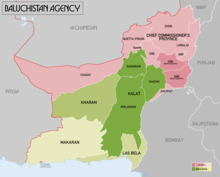| Revision as of 07:48, 15 October 2024 editSir Calculus (talk | contribs)Extended confirmed users1,558 edits Restored revision 1246024285 by Sutyarashi (talk): Rv disruptionTags: Twinkle Undo Reverted← Previous edit | Revision as of 09:17, 15 October 2024 edit undoRealEricson (talk | contribs)83 editsm Rv disruptionTags: Manual revert Reverted Visual edit Mobile edit Mobile web editNext edit → | ||
| Line 1: | Line 1: | ||
| '''Brahuistan''', also known as '''Brahvistan''' ({{lang-brh|براھوئستان}}; {{literally|Land of the Brahuis}}) is a region in ] in what are now ] and ] primarily inhabited by the ], an ethnic group which |
'''Brahuistan''', also known as '''Brahvistan''' ({{lang-brh|براھوئستان}}; {{literally|Land of the Brahuis}}) is a region in ] in what are now ] and ] primarily inhabited by the ], an ethnic group which speaks the ] as well as the ]. <ref name="Elfenbein" /> | ||
| Historically Brahuis were pastoralists primarily confined to the Kalat region; in the 17th century various Brahui tribes were unified by the Brahui Ahmedzai dynasty which led to the creation of ] or the "Brahui Confederacy".<ref name=Elfenbein>{{Encyclopædia Iranica|last1= Elfenbein |first1=Josef| volume = 4 | fascicle = 4 | title = Brahui |author-link = | url = https://www.iranicaonline.org/articles/brahui | pages = 433–443}}</ref> At its greatest extent in the 18th century, the Brahui confederacy controlled the wider ] region. However, the traditional territory of the Brahuis is a narrow corridor stretching from ] in the north to ] in the south,<ref name=Elfenbein/> separating the ]-majority regions in the northern Balochistan from the ]-majority ]. | |||
| ] (dark green) in ] (1931), subdivided into ], ] and ]]] | ] (dark green) in ] (1931), subdivided into ], ] and ]]] | ||
| Brahuistan is further divided into two major parts, ] in the north and ] in the south, inhabited by the Sarawani and Jhalawani Brahui tribes, respectively.<ref name=Elfenbein/> Today most of Brahuistan, with the exception of Nushki, is part of ]. According to the ], the districts of Khuzdar, Nushki, ], ] and ] have Brahui majority. Kalat Division, which consists of most of the former state of Kalat, is the only Brahui-majority ].<ref name="2023census">{{cite web |url=https://www.pbs.gov.pk/sites/default/files/population/2023/tables/balochistan/dcr/table_11.pdf |title=Population by mother tongue, sex and rural/urban, census-2023|publisher=]}}</ref> | Brahuistan is further divided into two major parts, ] in the north and ] in the south, inhabited by the Sarawani and Jhalawani Brahui tribes, respectively.<ref name=Elfenbein/> Today most of Brahuistan, with the exception of Nushki, is part of ]. According to the ], the districts of Khuzdar, Nushki, ], ] and ] have Brahui majority. Kalat Division, which consists of most of the former state of Kalat, is the only Brahui-majority ].<ref name="2023census">{{cite web |url=https://www.pbs.gov.pk/sites/default/files/population/2023/tables/balochistan/dcr/table_11.pdf |title=Population by mother tongue, sex and rural/urban, census-2023|publisher=]}}</ref> | ||
Revision as of 09:17, 15 October 2024
Brahuistan, also known as Brahvistan (Template:Lang-brh; lit. 'Land of the Brahuis') is a region in Balochistan in what are now Pakistan and Afghanistan primarily inhabited by the Brahuis, an ethnic group which speaks the Brahui language as well as the Balochi language.
Historically Brahuis were pastoralists primarily confined to the Kalat region; in the 17th century various Brahui tribes were unified by the Brahui Ahmedzai dynasty which led to the creation of Khanate of Kalat or the "Brahui Confederacy". At its greatest extent in the 18th century, the Brahui confederacy controlled the wider Balochistan region. However, the traditional territory of the Brahuis is a narrow corridor stretching from Nushki in the north to Khuzdar in the south, separating the Pashtun-majority regions in the northern Balochistan from the Baloch-majority Makran.

Brahuistan is further divided into two major parts, Sarawan in the north and Jhalawan in the south, inhabited by the Sarawani and Jhalawani Brahui tribes, respectively. Today most of Brahuistan, with the exception of Nushki, is part of Kalat Division. According to the 2023 Census of Pakistan, the districts of Khuzdar, Nushki, Kalat, Mastung and Surab have Brahui majority. Kalat Division, which consists of most of the former state of Kalat, is the only Brahui-majority division of Balochistan.
References
- ^ Elfenbein, Josef (1989). "Brahui". In Yarshater, Ehsan (ed.). Encyclopædia Iranica. Vol. IV/4: Bolbol I–Brick. London and New York: Routledge & Kegan Paul. pp. 433–443. ISBN 978-0-71009-127-7.
- "Population by mother tongue, sex and rural/urban, census-2023" (PDF). Pakistan Bureau of Statistics.
Further reading
- Zeb, Rizwan (2019). Ethno-political Conflict in Pakistan: The Baloch Movement (1 ed.). New York: Routledge. doi:10.4324/9780429318139. ISBN 978-0-429-31813-9.